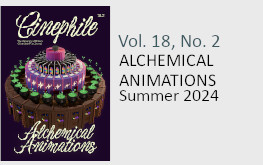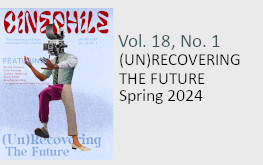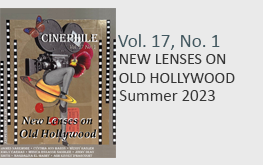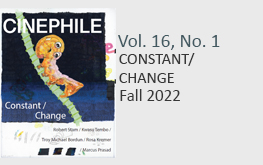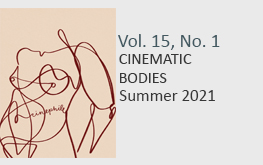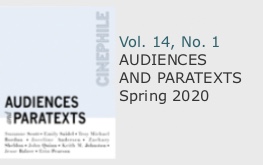Colleen Montgomery and Brent Strang
There are certain scenes which have the power to enthral, provoke, and delight—our cover captures one such titillating tableau. But what gives such a scene the ability to stand apart, to take on a life of its own? What is it about Robert De Niro’s “Are you talking to me?” scene that has such lasting cultural resonance? How does Gene Kelly dancing in the rain embody an entire ethos of escapism?
A scene sets up a world, a distinct time and place that draws us in and holds us captive. Not only does the scene invite us to engage with its reality (or unreality), but also to navigate its many ontological avenues for meaning. Some scenes clearly mark their boundaries, while others lose their definition and acquiesce to narrative momentum, effacing their beginning, middle, and end in favour of one or two privileged moments. A scene may be isolated as a synecdoche for a whole film, genre, director’s oeuvre, or national cinema. So, too, is our appreciation of certain films, directors, and performers frequently remembered as a repertoire of key scenes; just as there is cult film, there is a cult of the scene. Viral videos and homespun video mash-ups (each with a profusion of hits, comments, and links to related material) are perhaps the greatest testament to the scene’s power to continually inspire reflection and creative interaction.
In addition to being one of the primary sites of fandom, the scene is also one of the first points of entry for scholarly analysis. A sequence analysis is one of the key skills a film student learns before turning to more rigorous and rhetoric-based argumentation, but this ‘amateur’ exercise also proves useful for approaching contemporary viewing practices. Portable media devices, YouTube, DVD/Blu-ray scene selection, downloadable movies and trailers have all reframed our viewing habits. In this changing climate of spectatorship and cinephilia, scene studies offer an opportunity to reconcile cinephilic appreciation within film scholarship.
In keeping with this evolving viewing culture, we have conceived this issue as an interactive experience: on our newly redesigned website—cinephile.ca—each article is accompanied by an embedded video clip of the scene, and a comments forum for discussion. You will also find a short film created by Elena del Rio (and co-director Miriam Cooley) which, like her Foreword, delves into the scene’s affective potential to resonate profoundly and communicate viscerally.
Kicking off this issue, Brenda Austin Smith highlights just such a scene in Alice in the Cities—an example of what she calls ‘vertiginous cinema’—that both captivates and dislocates us emotionally and physically in a way we cannot fully explain. Conceptualizing how the scene can function as the thematic or ideological kernel of a film or cycle of films, Murray Pomerance illuminates the fire motif of two framing scenes in Torn Curtain and Brent Strang posits the ‘Cantina Scene’ in Three Burials as representative of the Post-Mortem Western.
Contemplating the scene’s reliance on music video logic, Brian Fauteaux underscores the iconic significance of the televised performance scene in Control, while R. Colin Tait shows how ‘That 70s Sequence’ in Summer of Sam partakes of an overarching trend within the genealogy of the musical montage. Revisiting the Snuffcoda, Alexandra Heller-Nicholas uncovers a largely unseen element of the controversial scene—one that destabilizes the swarm of early feminist and moralist criticism surrounding the film’s depiction of ‘real’ murder. Tackling another scene infamous for its violent, explicit content, Jessica Hughes examines the ‘naked fight scene’ in Eastern Promises. Lastly, two articles consider the surveillant gaze through a Lacanian lens: Larrie Dudenhoeffer likens the visual regime in Rear Window to ocular strabismus and Seung-hoon Jeong decodes the role of video interface in Caché’s suicide scene.
Engaging with alternate forms of spectatorship and exploiting new, interdisciplinary perspectives, this collection of articles is aptly suited to the journal’s mandate of widening the scope of the film studies discipline. Affirming its position as the preeminent Canadian graduate journal in film studies, Cinephile focuses on research attuned to the dissolution of boundaries (film/cultural studies, film/video, high/low art, etc.) and encourages articles that deploy film theory with a clever balance of novelty and irreverence. For making this issue possible, we must graciously acknowledge our advisor Ernest Mathijs, our administrators, Gerald Vanderwoude and Jennifer Suratos, art director Bobby Mathieson, and cover illustrator Barret Chapman, our editorial board, and of course, UBC’s Department of Theatre and Film.
If our cover hasn’t already seduced you to become a subscriber, our original content—designed to satisfy all your cinephilic appetites—surely will!

